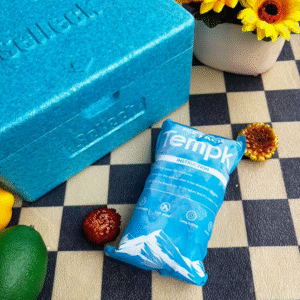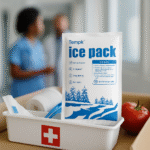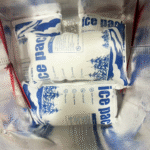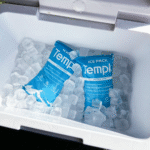Insulated Dry Ice Packs: How to Ship Perishables Safely?
Shipping perishable goods, especially in the food and pharmaceutical sectors, requires careful attention to temperature control. Insulated dry ice packs are a critical solution for ensuring the safe transport of items like seafood, vaccins, et des échantillons biologiques. These packs combine ultracold dry ice with high-performance insulation, providing consistent cooling without moisture. This article explores how insulated dry ice packs work, their key benefits, and best practices for use in cold-chain logistics.
-
How insulated dry ice packs ensure safe shipping for perishable goods.
-
Key benefits of using dry ice for cold-chain shipping.
-
How to select the right insulated dry ice pack for different products.
-
Bonnes pratiques pour l'emballage et l'expédition avec de la neige carbonique.
-
Key regulatory considerations when using dry ice in shipping.
What Are Insulated Dry Ice Packs and How Do They Work?
Insulated dry ice packs are essential tools in cold-chain logistics, providing effective temperature control for temperature-sensitive shipments. Glace sèche, avec un point de sublimation de -78,5°C, transforms directly from a solid to gas, providing an efficient cooling effect without the mess of melted water. These packs work by encasing dry ice in insulated containers, slowing its sublimation process and extending its cooling duration.
Key Benefits of Using Insulated Dry Ice Packs:
-
Contrôle de température efficace: Dry ice offers reliable cooling, ideal for long-distance shipments where precise temperature regulation is necessary.
-
Sans humidité: Contrairement à la glace ordinaire, la neige carbonique se sublime en gaz, ne laissant aucune humidité derrière, which can otherwise lead to spoilage or product damage.
-
Extended Shipping Durations: With insulated packs, dry ice can maintain its cooling effect for up to 72 heures ou plus, ensuring safe delivery.
-
Solutions personnalisables: Insulated dry ice packs can be tailored in size and quantity to suit different shipment requirements, allowing for precise control over cooling durations.
Insulated Dry Ice vs. Glace traditionnelle: Which is Better for Cold-Chain Shipping?
Table de comparaison:
| Fonctionnalité | Insulated Dry Ice Packs | Glace traditionnelle |
|---|---|---|
| Température | -78.5°C (sublimer le gaz) | 0°C (fond dans l'eau) |
| Durée | 24-72 heures | 6-24 heures |
| Humidité | Pas d'humidité | Fond dans l'eau |
| Efficacité de refroidissement | Haut, even for long shipments | Modéré, requires more insulation |
| Stockage & Taille | Compact, dense | Volumineux, requires more space |
Résumé:
Insulated dry ice packs offer a more efficient and moisture-free solution for long-haul shipments, making them the ideal choice for temperature-sensitive goods.
Best Practices for Using Insulated Dry Ice Packs in Cold-Chain Shipping
1. Determine the Correct Amount of Dry Ice for Your Shipment:
The right amount of dry ice depends on several factors, including the size of the shipment, transport duration, and product type. As a general guideline, utiliser 1-2 lbs de glace sèche par 24 hours for each cooler. For longer shipments or larger quantities of goods, adjust accordingly to ensure proper cooling.
2. Proper Packing Techniques for Insulated Dry Ice Packs:
To maximize efficiency, position dry ice at the bottom of the container. This allows the cold air to rise and circulate evenly. Seal your products in airtight bags or vacuum-sealed containers to prevent exposure to air, which could degrade the goods.
3. Adhere to Regulatory Guidelines for Dry Ice Shipping:
-
Étiquetage: It’s crucial to label dry ice shipments with the phrase “Carbon Dioxide Solid” and the weight of the dry ice.
-
Conditionnement: Use containers approved for dry ice shipping that allow the sublimating gas to escape. Cela empêche l'accumulation de pression, Assurer un transport sûr.
4. Use the Right Shipping Containers:
Select insulated containers that are specifically designed for dry ice to help regulate the temperature and allow the gas to escape safely. Specialized cooler bags or boxes are ideal.
5. Use Temperature Monitoring Sensors for Real-Time Data:
Monitor the temperature inside the container throughout the shipment using IoT-enabled sensors. These sensors provide real-time data, ensuring you can respond quickly if the temperature deviates from the desired range.
2025 Trends in Cold-Chain Shipping and Dry Ice Technology
Key Developments in Dry Ice Technology:
-
Automated Dry Ice Distribution: Advances in automation allow for on-demand distribution of dry ice based on the exact temperature conditions of each shipment.
-
Production durable: Efforts are being made to reduce the environmental impact of dry ice production by exploring carbon-capture methods and improving sustainability.
Market Insights for 2025:
-
Emballage durable: With the growing demand for eco-friendly shipping, we can expect more innovations in recyclable dry ice packaging.
-
Logistique intelligente: AI-driven logistics platforms are revolutionizing the way businesses manage shipping routes and optimize dry ice usage, improving cost-efficiency and reliability.
FAQ: Insulated Dry Ice Packs in Cold-Chain Shipping
Q1: How long can perishables stay cold with insulated dry ice packs?
UN: Depending on the size of the shipment and the quantity of dry ice used, perishables can stay cold for up to 72 heures ou plus.
Q2: Are there any special regulations for shipping with dry ice?
UN: Oui, shipments containing more than 5.5 lbs of dry ice require specific labeling and paperwork under DOT and IATA regulations.
Q3: How do I safely handle dry ice during shipping?
UN: Always use insulated gloves and eye protection when handling dry ice, and ensure the shipping container allows gas to escape to avoid pressure buildup.
Conclusion et recommandations
Insulated dry ice packs are essential for maintaining the integrity of perishable goods during shipment. By using the correct amount of dry ice, ensuring proper packing, and adhering to regulations, businesses can maintain optimal product quality throughout transport. Staying updated with 2025 trends like sustainable packaging and smart logistics will help optimize your cold-chain operations.
Étapes suivantes:
-
Evaluate your current shipping methods and consider integrating dry ice for improved temperature control.
-
Contact a cold-chain logistics provider to discuss how insulated dry ice packs can streamline your shipping operations.
-
Ensure compliance with all regulations when shipping goods with dry ice.
À propos du tempk
Et tempk, we specialize in cold-chain packaging solutions, including high-quality insulated dry ice packs. Our products help businesses ensure the safe transport of perishable goods, médicaments, and biotech samples. Reach out to Tempk for expert advice on optimizing your cold-chain logistics.
Contact Tempk Today: To learn more about how our insulated dry ice packs can improve your shipping operations, get in touch with our experts.
























